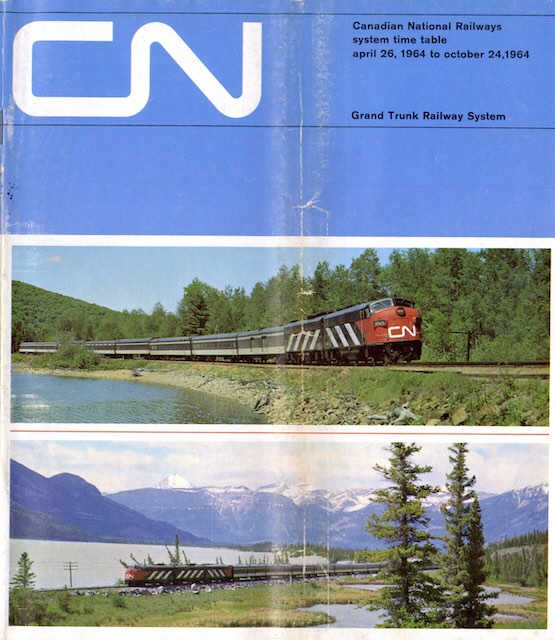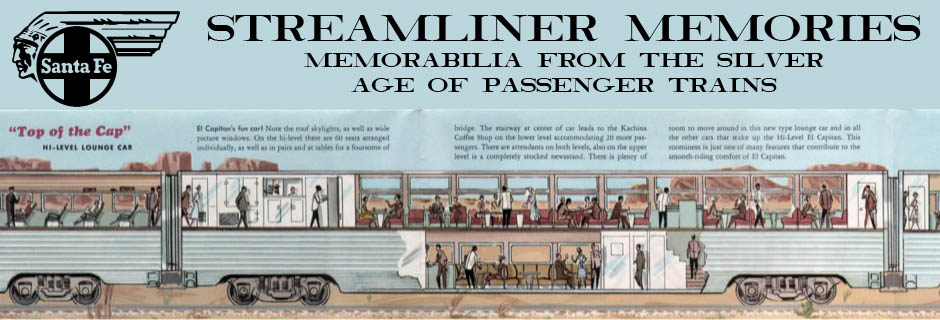On May 24, 1964, Canadian National introduced a new train: the Panorama, which replaced the Continental as the railway’s secondary transcontinental. The train carried three transcontinental coaches, seven transcontinental sleepers (plus one between Saskatoon and Jasper), a diner, cafe, and two lounge cars (one for coach and one for first-class).
 Click image to download a 46.4-MB PDF of this 68-page timetable.
Click image to download a 46.4-MB PDF of this 68-page timetable.
Two full-page ads, one in English and one in French, claim that the Panorama is an “identical twin” to the Super Continental with the same “top speed” schedule only during different hours so people could take a choice. These claims are typically exaggerated.
In fact, the Panorama‘s schedule was about ten hours shorter than the Continental but it was still about six hours longer than the Super‘s. Moreover, it appears that most of the equipment on the Panorama consisted of heavyweight cars taken from the Continental, making it at best a fraternal, not an identical, twin to the mostly lightweight Super Continental. The biggest difference is that the tourist sleepers that were on the Continental were not included in the Panorama, a fact that would disappoint many people on a budget who still wanted a bed to sleep in.
Aside from the new train, this timetable is differs from yesterday’s in one key way: the centerfold map is no longer in the centerfold. CN probably questioned locating its map in the centerfold because Canada was big enough that it used two spreads for its map: one for western Canada and one for eastern, with an overlap in the vicinity of Lake Superior. This went at least as far back as the 1940s and probably the 1930s as well.
In yesterday’s timetable, western Canada came first while eastern Canada was in the centerfold. In today’s timetable, both maps are relegated to the back on pages numbered 52 through 55 (out of 64 numbered pages; the cover pages aren’t numbered). A look back at previous timetables shows this practice actually began with the October 1963 edition, which was shown here several years ago.
An ad on the page numbered 39 reminds me of another issue with railroad timetables: Daylight Savings Time, which as of 1964 had been inconsistently adopted by Canadian provinces and cities. The ad points out that most provinces that used Daylight time did so from April 24 through October 26, but in Manitoba it ended on September 13. Alberta didn’t use it at all, nor did certain cities and regions of New Brunswick, Ontario, Quebec (including the entire Gaspé peninsula), and Saskatchewan. Though CN had been publishing its Newfoundland schedules in Daylight time for years, elsewhere the variation “makes it necessary for CN to use Standard Time for all its trains on the mainland.”
As I’ve perused the more than 200 timetables I’ve posted here in the last year, I’ve noted a pattern in the back of my mind. Up through the mid-1950s, railroads issued timetables any old time they wanted to, sometimes as many as four a year. After approximately 1956, many railroads settled into usually issuing two timetables a year, one in April and one in October. Even if they issued more than two, there was always one in April and one in October.
It recently hit me that the semi-annual changes between Standard and Daylight time were probably responsible for this trend. The Pennsylvania Railroad, the “standard railroad of the world,” started publishing its timetables in Daylight time in 1957 but most other railroads did not follow that standard, knowing that the worst that could happen would be that some people would show up for trains an hour early.
In 1966, the national governments of both Canada and the United States formally adopted Daylight Savings nationwide (with a few exceptions) and railroads then followed suit. But their issuance of new timetables in April and October at least a decade earlier must have been influenced by the semi-annual time changes even if they didn’t formally adhere to those changes.
